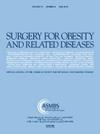美国代谢与减肥手术协会关于代谢与减肥手术后边缘溃疡的风险因素、筛查建议和预防措施的文献综述。
IF 3.5
3区 医学
Q1 SURGERY
引用次数: 0
摘要
背景:边缘溃疡(MU)是吻合口代谢和减肥手术(包括 Roux-en-Y 胃旁路术 (RYGB)、单吻合口胃旁路术 (OAGB) 和十二指肠转流胆胰转流术 (BPD/DS))后的重要术后并发症。本综述总结了目前有关 MU 风险因素、筛查和预防策略的知识:本综述旨在研究 MU 的技术和患者相关风险因素、评估筛查策略并推荐预防方法,以降低吻合器代谢和减肥手术 (MBS) 后的 MU 发生率:美国代谢与减肥手术学会(ASMBS)临床问题委员会成员根据 2000 年至今的现有文献进行了一次全面审查:方法:使用 Ovid MEDLINE 和 PubMed 数据库进行系统检索。对相关研究进行了筛选。对技术因素和患者相关因素进行了评估,并提出了预防 MU 的建议:结果:发现了导致 MU 的几个风险因素,包括胃袋过大、环形缝合吻合口、使用不可吸收缝线、吸烟、使用非甾体抗炎药和免疫抑制。虽然预防性质子泵抑制剂(PPI)疗法被广泛推荐,但其最佳疗程仍存在争议。幽门螺杆菌在 MU 发病中的作用尚未明确:结论:手术后至少 3 个月的预防性 PPI 治疗可显著降低 MU 风险。风险分层和个体化治疗方案对于最大限度地减少术后并发症至关重要。要明确幽门螺杆菌的作用并优化预防策略,还需要进一步的研究。本文章由计算机程序翻译,如有差异,请以英文原文为准。
American Society for Metabolic and Bariatric Surgery literature review on risk factors, screening recommendations, and prophylaxis for marginal ulcers after metabolic and bariatric surgery
Background
Marginal ulcers (MU) are a significant postoperative complication following anastomotic metabolic and bariatric surgeries including Roux-en-Y gastric bypass (RYGB), one-anastomosis gastric bypass (OAGB), and biliopancreatic diversion with duodenal switch (BPD/DS). This review summarizes current knowledge on MU risk factors, screening, and prophylactic strategies.
Objectives
The goal of this review is to examine technical and patient-related risk factors for MU, assess screening strategies, and recommend prophylactic approaches to reduce MU incidence after anastomotic metabolic and bariatric surgery (MBS).
Setting
A comprehensive review was conducted by members of the American Society for Metabolic and Bariatric Surgery (ASMBS) Clinical Issues Committee, based on available literature from 2000 to the present.
Methods
A systematic search was performed using Ovid MEDLINE and PubMed databases. Relevant studies were screened for inclusion. Technical and patient-related factors were evaluated, and recommendations for MU prevention were formulated.
Results
Several risk factors for MU were identified, including large gastric pouch size, circular stapled anastomoses, use of nonabsorbable sutures, smoking, nonsteroidal anti-inflammatory drugs use, and immunosuppression. While prophylactic proton pump inhibitor (PPI) therapy is widely recommended, its optimal duration remains debated. The role of Helicobacter pylori in MU development is not clearly defined.
Conclusions
Prophylactic PPI therapy for at least 3 months postsurgery significantly reduces the risk of MU. Risk stratification and individualized treatment plans are essential to minimize postoperative complications. Further research is needed to clarify the role of H. pylori and optimize prophylactic strategies.
求助全文
通过发布文献求助,成功后即可免费获取论文全文。
去求助
来源期刊
CiteScore
6.70
自引率
12.90%
发文量
570
审稿时长
56 days
期刊介绍:
Surgery for Obesity and Related Diseases (SOARD), The Official Journal of the American Society for Metabolic and Bariatric Surgery (ASMBS) and the Brazilian Society for Bariatric Surgery, is an international journal devoted to the publication of peer-reviewed manuscripts of the highest quality with objective data regarding techniques for the treatment of severe obesity. Articles document the effects of surgically induced weight loss on obesity physiological, psychiatric and social co-morbidities.

 求助内容:
求助内容: 应助结果提醒方式:
应助结果提醒方式:


